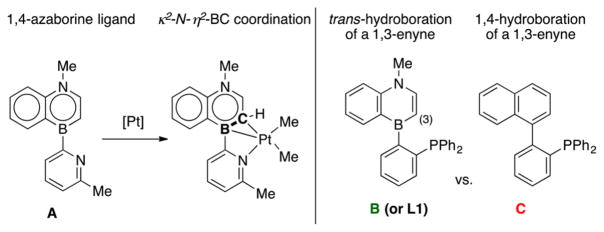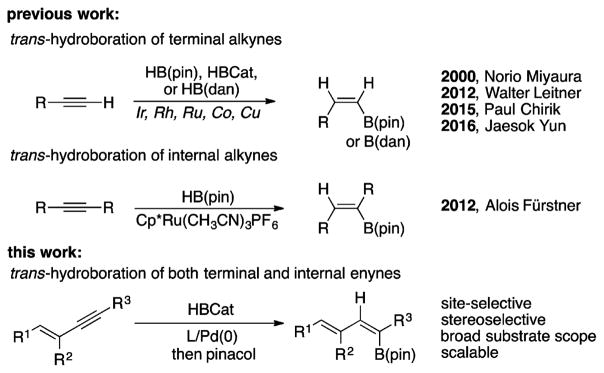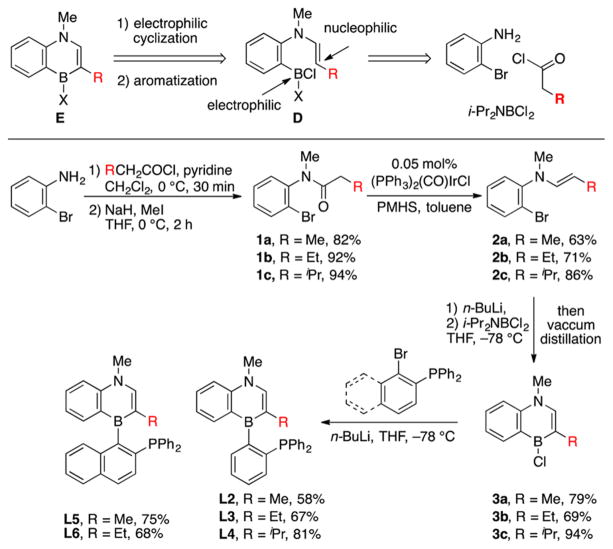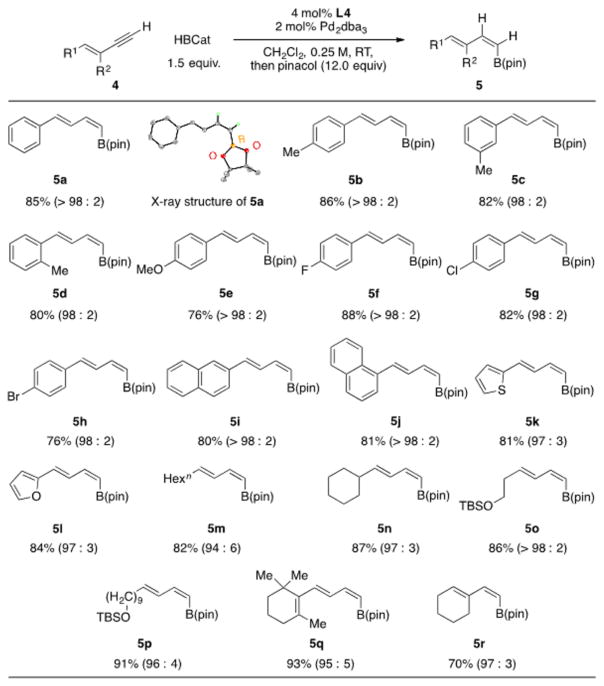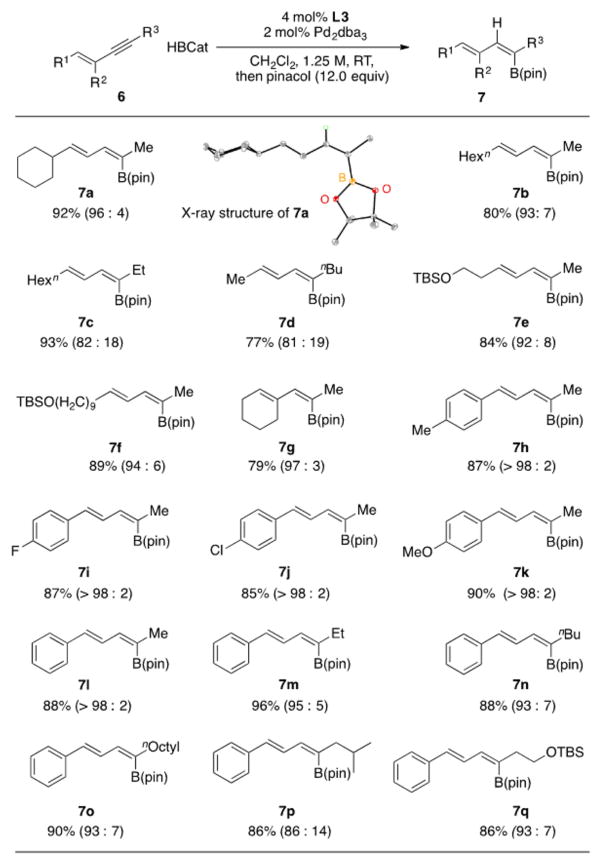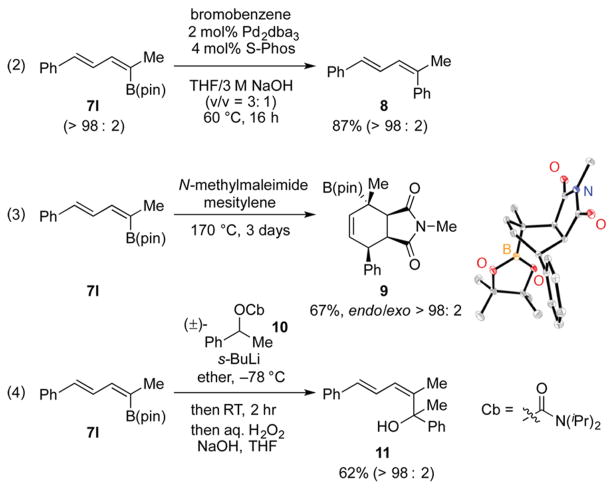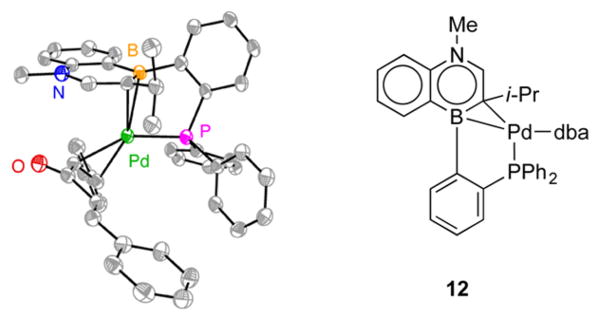Abstract
A concise synthesis of monobenzofused 1,4-azaborine phosphine ligands (Senphos) is described. These Senphos ligands uniquely support Pd-catalyzed trans-selective hydroboration of terminal and internal 1,3-enynes to furnish corresponding dienylboronates in high efficiency and diastereoselectivity. X-ray structural analysis of the Senphos–Pd(0) complex reveals a κ2-P-η2-BC coordination mode, and this isolated complex has been shown to serve as a competent catalyst for the trans-hydroboration reaction. This work demonstrates that the expanded chemical space provided by the BN/CC isosterism approach translates into the functional space in the context of stereoselective catalytic transformations.
BN/CC isosterism, i.e., the replacement of a CC bond unit with the isoelectronic and isosteric BN bond unit, has recently emerged as a viable strategy to increase the structural diversity of organic molecules.1 While early applications have appeared in the area of materials science2 and biomedical research,3 efforts taking advantage of expanded chemical space provided by BN/CC isosterism in ligand-supported catalysis for organic synthesis have lagged behind.4–6 This is surprising in view of tremendous opportunities for achieving new reactivity and selectivity in catalytic transformations that the electronic tuning through BN/CC isosterism could potentially provide. In a recent example, we disclosed that the 1,4-azaborine-based pyridine ligand A (Scheme 1) exhibits a κ2N-η2-BC coordination with group 10 transition metals and that the phosphine derivative B in conjunction with Pd could uniquely catalyze the hydroboration of a terminal enyne in a trans-selective fashion.7 In contrast to B, the corresponding carbonaceous phosphine ligand isostere C behaves more similarly to a monodentate phosphine such as PPh3 in terms of hydroboration selectivity and yield, producing preferentially allenes via 1,4-hydroboration; bisphosphine ligands such as 1,2-bis(diphenylphosphino)ethane (dppe) furnish syn-hydroboration products exclusively.8 Despite this promising preliminary result, our trans-hydroboration reaction still needed optimization with regard to yield and selectivity. More importantly, we wondered whether we could develop a trans-hydroboration protocol for internal enynes, a substrate class that is considered significantly more challenging (vide infra).
Scheme 1.
An Application of BN/CC Isosterism in Catalysis
To date, only a handful of metal-catalyzed systems have been demonstrated to achieve trans-hydroboration of alkynes.9 Miyaura reported the first example in 2000 using Ir or Rh catalysts (Scheme 2).10 In 2012, Leitner showed that a Ru/PNP pincer complex can produce Z-vinylboronates via trans-hydroboration of alkynes with H-Bpin,11 and Chirik introduced a Co-based system in 2015.12 What these systems have in common is that they require the presence of the terminal alkyne proton due to the operating reaction mechanisms. Metal vinylidene species have been proposed for the Miyaura10 and Leitner11 catalysts whereas the Chirik system involves a Co-alkynyl12 intermediate. Thus, internal enynes would not be suitable substrates for these systems. Lee and Yun reported very recently a copper(I)–thiophene-2-carboxylate/DPEphos catalyzed trans-hydroboration of terminal aryl-alkynes in which the terminal alkyne proton does not undergo a migration that is observed in the Miyaura, Leitner, and Chirik systems.13 To the best of our knowledge, the only metal-catalyzed system that can achieve the trans-hydroboration of internal alkynes is the [Cp*Ru(MeCN)3]PF6 system by Fürstner.14 This system works particularly well with symmetrical internal alkynes, and enynes have been pointed out as a problematic substrate for Fürstner’s Ru catalyst.
Scheme 2.
Transition-Metal-Catalyzed trans-Selective Hydroboration of Alkynes
In this communication, we disclose a Pd-catalyzed trans-selective hydroboration of both terminal and internal 1,3-enynes with high site selectivity and stereoselectivity that is supported by 1,4-azaborine-based phosphine ligands. Key to the successful development of this reaction is a new, concise synthesis of monobenzofused 1,4-azaborine phosphines (Senphos), which we report here as well.
Our original synthesis of Senphostype ligands via ring-closing metathesis7 was unfortunately not amenable to scale-up15 and ready modification of the C(3) position, which we believe could play an important role due to its proximity to the catalytically active Pd metal. This synthetic limitation significantly hampered our ability to develop a general and versatile trans-hydroboration protocol. Recognizing that N-vinyl-B-Cl intermediate D (Scheme 3, top) contains a nucleophilic enamine and an electrophilic boron atom, we envisioned that D could be poised to undergo intramolecular electrophilic cyclization16 to furnish C3-substituted monobenzofused 1,4-azaborine E after aromatization, thus circumventing the limiting ring-closing-metathesis approach. Intermediate D should be accessible from commercially available 2-bromoaniline, a variety of acyl chlorides, and (diisopropylamino)boron dichloride.
Scheme 3.
Retrosynthetic Analysis and Preparation of Senphos Ligands L2–L6
With a new synthetic strategy in hand, we began our synthesis of a library of ligands with the acylation and methylation of 2-bromoaniline to provide amides 1a–c. The critical enamine functionality was introduced using a protocol developed by Nagashima.17 Treatment of 1 with polymethylhydrosiloxane (PHMS) in the presence of 0.05 mol% of Vasaka’s complex (PPh3)2(CO)IrCl as a catalyst furnished the corresponding enamines 2a–c in 63–86% yield. Subsequent lithium–halogen exchange followed by addition of i-Pr2NBCl2 and distillation of the resulting reaction mixture under attenuated pressure afforded directly the versatile B-Cl-substituted monobenzofused 1,4-azaborines 3a–c.18 The structure of 3a is further unambiguously confirmed by single crystal X-ray diffraction analysis (see Supporting Information). Finally, the substitution reaction of 3a–c with phosphine-containing organolithium nucleophiles gave targeted Senphos ligands L2–6.
We chose terminal E-1,3-enyne 4a as our initial substrate to probe the effects of the ligand structure on the trans-hydroboration selectivity. In the presence of 4 mol % catalyst “L1 (= B)/Pd(0)”, reaction of 4a with 1 equiv of catecholborane (HBCat) in CH2Cl2 at room temperature and subsequent transesterification with pinacol19 afforded the corresponding trans-hydroboration product 5a with decent trans-hydroboration stereoselectivity (93:7) in 59% yield (Table 1, entry 1). No background reaction was observed in the absence of the catalyst under otherwise identical reaction conditions. The C3-substituent in L plays an important role in the optimization of stereoselectivity. For example, when L4, which bears the sterically more demanding i-Pr group at the C3 position, is used as the ligand, the reaction gave superior (>98:2) trans-hydroboration selectivity compared to those with the smaller substituents (Table 1, entry 4 vs entries 1–3). Switching the boron substituent from the o-diphenylphosphinophenyl to 2-diphenylphosphinonaphth-1-yl group did not result in obvious trends in terms of both reactivity and stereoselectivity (Table 1, entry 2 vs 5, entry 3 vs 6). The isolated yield of dienylboronate ester 5a could be elevated to 86% when 1.5 equiv of CatBH is used instead of 1.0 equiv (Table 1, entry 7).
Table 1.
Ligand Survey of trans-Hydroboration of Terminal 1,3-Enyne 4a Catalyzed by L/Pd(0)

| |||
|---|---|---|---|
| entry | L | trans-hydroboration selectivitya | yield (%)b |
| 1 | L1 | 93:7 | 59 |
| 2 | L2 | 92:8 | 60 |
| 3 | L3 | 96:4 | 56 |
| 4 | L4 | >98:2 | 62 |
| 5 | L5 | 96:4 | 59 |
| 6 | L6 | 94:6 | 68 |
| 7c | L4 | >98:2 | 86 |
The diastereomeric ratio was determined by 1H NMR of crude material before addition of pinacol.
Yield of isolated product, based on 4a.
1.5 equiv of HBC was applied. dba: dibenzylidineacetone.
Under optimized reaction conditions, various terminal E-1,3-enynes 4 were subjected to the trans-selective hydroboration, and the results are summarized in Table 2. High yield and trans-selectivity were observed consistently with an array of electronically and sterically different substituents on the alkene. The stereochemistry of dienylboronate 5a was confirmed by single crystal X-ray diffraction analysis (Table 2).
Table 2.
trans-Hydroboration of Terminal 1,3-Enynes 4 Catalyzed by L4/Pd(0)a
Yield of isolated product (average of 2 runs), based on 4. The diastereomeric ratio in parentheses was determined by 1H NMR of crude material before addition of pinacol.
The metal-catalyzed trans-hydroboration of internal 1,3-enynes is a significantly more demanding problem and has currently no precedent in the literature. Internal 1,3-enynes are generally less reactive toward hydroboration, and the control of both site selectivity and stereoselectivity is more challenging.20 Gratifyingly, when the concentration of the reaction is increased from 0.25 to 1.25 M,21 the reaction of internal E-1,3-enyne 6a with CatBH (see eq 1) in the presence of 4 mol % L1/Pd was complete
 |
(1) |
within 90 min at room temperature, affording 7a in 89% yield with 90:10 trans-hydroboration selectivity after treatment with pinacol. Other regioisomers were not observed. Further optimization with regard to the ligand structure revealed that the C3-ethyl substituted L3 was the best performing ligand producing 7a in 92% yield and 96:4 trans-hydroboration selectivity.22
The substrate scope for the trans-hydroboration of internal 1,3-enynes is summarized in Table 3. In general, 1,4-disubstituted 1,3-eynes 6 bearing an aryl group at the R1 position gave superior trans-hydroboration selectivity compared to alkyl groups (Table 3, entries 7h–7l vs 7a–7g). Increasing the substituent size of the R3 substituent in 6 reduces trans-hydroboration selectivity (Table 3, entries 7l–7p, in particular 7l vs 7p). The bond connectivity of dienylboronate 7a and the hydroboration stereoselectivity were unambiguously confirmed by the solid-state structure of 7a (Table 3).
Table 3.
trans-Hydroboration of Internal 1,3-Enynes 6 Catalyzed by L3/Pd(0)a
Yield of isolated product (average of 2 runs), based on 6. The diastereomeric ratio in parentheses was determined by 1H NMR of crude material before addition of pinacol.
Our method is amendable to scale up. Trans-hydroboration of 1,3-enyne 6l (1.138 g, 8.0 mmol) with a reduced catalyst loading (1 mol % Pd) furnished the desired product 7l in 89% yield (1.819 g) without erosion of stereoselectivity (see Supporting Information).
Dienylboronate esters such as 7l are versatile intermediates in organic synthesis,23 and Scheme 4 illustrates that 7l is capable in engaging in subsequent C–C bond forming transformations stereospecifically. For example, 7l undergoes Pd catalyzed Suzuki–Miyaura24 coupling with bromobenzene to furnish 1,3-diene 8 in 83% yield with complete retention of the olefin stereochemistry (Scheme 4, eq 2). Furthermore, Diels–Alder reaction of 7l with N-methylmaleimide afforded bicyclic 9 containing four stereogenic centers with high diastereoselectivity (endo/exo >98:2) in 67% yield (Scheme 4, eq 3).25 Finally, homologation of 7l with deprotonated carbamate 10 followed by oxidation furnished corresponding dienol 11 in 62% yield (Scheme 4, eq 4).26
Scheme 4.
Functionalization of Hydroboration Product 7l
We were able to obtain the single crystal X-ray structure of Senphos L4 bound to Pd(0)dba. Scheme 5 shows that the κ2-P-η2-BC coordination mode to Pd(0) in complex 12 is preserved even with the sterically demanding i-Pr group at the C(3) position.27 Complex 12 is a chemically and kinetically competent catalyst. trans-Hydroboration of substrate 4a with the isolated Pd(0) complex 12 as the catalyst furnished the desired product 5a in the same amount of yield and diastereoselectivity within 30 min as described in Table 1.
Scheme 5.
Isolated Pd(0) Complex 12 Is a Competent Catalyst for trans-Hydroboration
In summary, we have developed a modular and concise synthesis of monobenzofused 1,4-azaborine-based phosphine ligands. Their Pd(0) complexes have been found to catalyze trans-hydroboration of both terminal and internal E-1,3-enynes with high site selectivity and stereoselectivity under mild conditions. The method is also amendable to gram-scale synthesis without erosion of selectivity. Mechanistic studies including the origin of trans-hydroboration selectivity and further application of Senphos ligands in catalytic transformations are currently underway in our laboratory.
Supplementary Material
Acknowledgments
This research was supported by the National Institutes of Health NIGMS (R01-GM094541) and Boston College start-up funds. We thank Dr. Lev Zakharav for solving the X-ray structure for 3a.
Footnotes
Notes
The authors declare no competing financial interest.
The Supporting Information is available free of charge on the ACS Publications website at DOI: 10.1021/jacs.6b09759.
Experimental procedures, spectroscopic data (PDF)
Crystallographic data (CIF, CIF, CIF, CIF, CIF)
References
- 1.For an overview, see: Liu Z, Marder TB. Angew Chem, Int Ed. 2008;47:242. doi: 10.1002/anie.200703535.Bosdet MJD, Piers WE. Can J Chem. 2009;87:8.Campbell PG, Marwitz AJV, Liu SY. Angew Chem, Int Ed. 2012;51:6074. doi: 10.1002/anie.201200063.
- 2.(a) Wang XY, Wang JY, Pei J. Chem - Eur J. 2015;21:3528. doi: 10.1002/chem.201405627. [DOI] [PubMed] [Google Scholar]; (b) Morgan MM, Piers WE. Dalton Trans. 2016;45:5920. doi: 10.1039/c5dt03991f. [DOI] [PubMed] [Google Scholar]
- 3.(a) Vlasceanu A, Jessing M, Kilburn JP. Bioorg Med Chem. 2015;23:4453. doi: 10.1016/j.bmc.2015.06.019. [DOI] [PubMed] [Google Scholar]; (b) Rombouts FJ, Tovar F, Austin N, Tresadern G, Trabanco AA. J Med Chem. 2015;58:9287. doi: 10.1021/acs.jmedchem.5b01088. [DOI] [PubMed] [Google Scholar]; (c) Sanchez Casado MR, Ciordia Jimenez M, Ariza Bueno M, Barriol M, Leenaerts JE, Pagliuca C, Martinez Lamenca C, De Lucas AI, Garcia A, Trabanco AA, Rombouts FJR. Eur J Org Chem. 2015;2015:5221. [Google Scholar]; (d) Davies GH, Molander GA. J Org Chem. 2016;81:3771. doi: 10.1021/acs.joc.6b00435. [DOI] [PMC free article] [PubMed] [Google Scholar]; (e) Amani J, Molander GA. Org Lett. 2015;17:3624. doi: 10.1021/acs.orglett.5b01750. [DOI] [PubMed] [Google Scholar]; (f) Molander GA, Wisniewski SR, Amani J. Org Lett. 2014;16:5636. doi: 10.1021/ol502708z. [DOI] [PMC free article] [PubMed] [Google Scholar]; (g) Liu L, Marwitz AJV, Matthews BW, Liu SY. Angew Chem, Int Ed. 2009;48:6817. doi: 10.1002/anie.200903390. [DOI] [PMC free article] [PubMed] [Google Scholar]; (h) Abbey ER, Zakharov LN, Liu SY. J Am Chem Soc. 2011;133:11508. doi: 10.1021/ja205779b. [DOI] [PMC free article] [PubMed] [Google Scholar]; (i) Abbey ER, Liu SY. Org Biomol Chem. 2013;11:2060. doi: 10.1039/c3ob27436e. [DOI] [PMC free article] [PubMed] [Google Scholar]; (j) Chrostowska A, Xu S, Mazière A, Boknevitz K, Li B, Abbey ER, Dargelos A, Graciaa A, Liu SY. J Am Chem Soc. 2014;136:11813. doi: 10.1021/ja5063899. [DOI] [PMC free article] [PubMed] [Google Scholar]; (k) Saif M, Widom JR, Xu S, Abbey ER, Liu SY, Marcus AH. J Phys Chem B. 2015;119:7985. doi: 10.1021/acs.jpcb.5b03485. [DOI] [PMC free article] [PubMed] [Google Scholar]; (l) Knack DH, Marshall JL, Harlow GP, Dudzik A, Szaleniec M, Liu SY, Heider J. Angew Chem, Int Ed. 2013;52:2599. doi: 10.1002/anie.201208351. [DOI] [PMC free article] [PubMed] [Google Scholar]; (m) Rudebusch GE, Zakharov LN, Liu SY. Angew Chem, Int Ed. 2013;52:9316. doi: 10.1002/anie.201304443. [DOI] [PMC free article] [PubMed] [Google Scholar]
- 4.For leading examples of coordination compounds with direct involvement of the azaborine ring atoms, see: Ashe AJ., III Organometallics. 2009;28:4236.Pan J, Kampf JW, Ashe AJ., III Organometallics. 2008;27:1345.Pan J, Kampf JW, Ashe AJ., III J Organomet Chem. 2009;694:1036.
- 5.For select other examples of coordination compounds associated with single BN/CC replacement, see: Bailey JA, Haddow MF, Pringle PG. Chem Commun. 2014;50:1432. doi: 10.1039/c3cc49000a.Bailey JA, Ploeger M, Pringle PG. Inorg Chem. 2014;53:7763. doi: 10.1021/ic501133n.Ko SB, Lu JS, Wang S. Org Lett. 2014;16:616. doi: 10.1021/ol403550b.
- 6.For leading references to 1,2-azaborolyl ligands as BN/CC isosteres of the cyclopentadienyl ligand, see: Schmid G. Comments Inorg Chem. 1985;4:17.Liu SY, Lo MMC, Fu GC. Angew Chem, Int Ed. 2002;41:174. doi: 10.1002/1521-3773(20020104)41:1<174::aid-anie174>3.0.co;2-7.
- 7.Xu S, Haeffner F, Li B, Zakharov LN, Liu SY. Angew Chem, Int Ed. 2014;53:6795. doi: 10.1002/anie.201403903. [DOI] [PubMed] [Google Scholar]
- 8.Matsumoto Y, Naito M, Hayashi T. Organometallics. 1992;11:2732. [Google Scholar]
- 9.For recent examples of nontransition-metal-mediated trans-hydroboration, see: Yuan K, Suzuki N, Mellerup SK, Wang X, Yamaguchi S, Wang S. Org Lett. 2016;18:720. doi: 10.1021/acs.orglett.5b03698.McGough JS, Butler SM, Cade IA, Ingleson MJ. Chem Sci. 2016;7:3384. doi: 10.1039/c5sc04798f.
- 10.Ohmura T, Yamamoto Y, Miyaura N. J Am Chem Soc. 2000;122:4990. [Google Scholar]
- 11.Gunanathan C, Hoelscher M, Pan F, Leitner W. J Am Chem Soc. 2012;134:14349. doi: 10.1021/ja307233p. [DOI] [PubMed] [Google Scholar]
- 12.Obligacion JV, Neely JM, Yazdani AN, Pappas I, Chirik PJ. J Am Chem Soc. 2015;137:5855. doi: 10.1021/jacs.5b00936. [DOI] [PubMed] [Google Scholar]
- 13.Jang WJ, Lee WL, Moon JH, Lee JY, Yun J. Org Lett. 2016;18:1390. doi: 10.1021/acs.orglett.6b00325. [DOI] [PubMed] [Google Scholar]
- 14.Sundararaju B, Fürstner A. Angew Chem, Int Ed. 2013;52:14050. doi: 10.1002/anie.201307584. [DOI] [PubMed] [Google Scholar]
- 15.Two relatively expensive catalysts were involved that had to be used at relatively high catalyst loadings: Grubbs second generation catalyst at 10 mol% loading, and [(PPh3)3(CO)(Cl)RuH] at 2 mol% loading.
- 16.For select recent examples, see: Hatakeyama T, Hashimoto S, Seki S, Nakamura M. J Am Chem Soc. 2011;133:18614. doi: 10.1021/ja208950c.Wang XY, Zhuang FD, Wang RB, Wang XC, Cao XY, Wang JY, Pei J. J Am Chem Soc. 2014;136:3764. doi: 10.1021/ja500117z.
- 17.Motoyama Y, Aoki M, Takaoka N, Aoto R, Nagashima H. Chem Commun. 2009:1574. doi: 10.1039/b821317h. [DOI] [PubMed] [Google Scholar]
- 18.Compounds 3a–c are formed after the exchange of the B-Ni-Pr2 group with the in situ generated HCl.
- 19.In order to isolate dienylboronate, the catecholboronate was converted to pinacolboronate prior to column chromatography using similar procedures in ref 10. No erosion of stereochemistry was observed after transesterification.
- 20.Sasaki Y, Horita Y, Zhong C, Sawamura M, Ito H. Angew Chem, Int Ed. 2011;50:2778. doi: 10.1002/anie.201007182. [DOI] [PubMed] [Google Scholar]
- 21.At 0.25 M concentration, the reaction was sluggish.
- 22.The use of an analogous carbonaceous ligand CC-L3 as the supporting ligand in the hydroboration reaction of 6l led to incomplete conversion and significant formation of cis- and 1,4-hydroboration byproducts; see Supporting Information for details.
- 23.Eberlin L, Tripoteau F, Carreaux F, Whiting A, Carboni B. Beilstein J Org Chem. 2014;10:237. doi: 10.3762/bjoc.10.19. [DOI] [PMC free article] [PubMed] [Google Scholar]
- 24.(a) Suzuki A. Angew Chem, Int Ed. 2011;50:6722. doi: 10.1002/anie.201101379. [DOI] [PubMed] [Google Scholar]; (b) Miyaura N, Suzuki A. Chem Rev. 1995;95:2457. [Google Scholar]
- 25.Hilt G, Bolze P. Synthesis. 2005;2005:2091. [Google Scholar]
- 26.Stymiest JL, Bagutski V, French RM, Aggarwal VK. Nature. 2008;456:778. doi: 10.1038/nature07592. [DOI] [PubMed] [Google Scholar]
- 27.For leading references on the effects of Pd–arene interactions in catalysis, see: Arrechea PL, Buchwald SL. J Am Chem Soc. 2016;138:12486. doi: 10.1021/jacs.6b05990.Barder TE, Walker SD, Martinelli JR, Buchwald SL. J Am Chem Soc. 2005;127:4685. doi: 10.1021/ja042491j.
Associated Data
This section collects any data citations, data availability statements, or supplementary materials included in this article.



